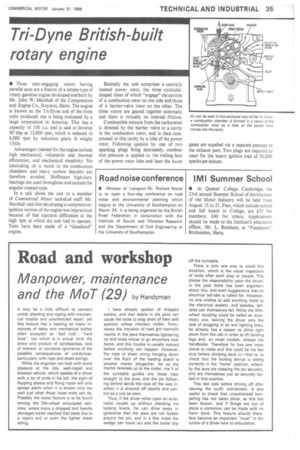Road and workshop
Page 37

If you've noticed an error in this article please click here to report it so we can fix it.
Manpower, maintenance
and the MoT (29) by Handyman
It may be a little difficult to connect untidy sheeting and roping with mechanical trouble and unscheduled repair, yet this feature has a bearing on many instances of delay and mechanical bother often accepted as ''bad luck", "hard lines", but which is in actual truth the direct end product of carelessness, lack of interest, or complete ignorance of the possible consequences of untidyness, particularly with rope and sheet strings.
While the engineer can look with some pleasure at the tidy, well-roped and sheeted vehicle, which speaks of a driver with a lot of pride in his job, the sight of flapping sheets and flying ropes will only spread alarm when it is known only too well just what these loose ends can de. Possibly the Worst feature is to be found among the 5th-wheel articulated vehicles, where many a dropped and heavily damaged trailer reached that state due to a rope's end or even the lighter sheet string.
I have already spoken of dropped trailers, and that debris in the jaws can cause the locks to stop short of their safe position unless checked visibly. Fortunately the intrusion of road grit normally results in the jaws themselves tightening up and locks refuse to go anywhere near home, and this trouble is usually noticed before anything can happen. However, the rope or sheet string hanging down over the front of the loading board is another matter altogether, for as the tractor reverses up to the trailer, the V of the turntable guides any loose rope straight to the jaws, and the pin following behind sends the rope all the way in, where it is sheared off cleanly and cannot as a rule be seen.
Thus, if the driver relies upon an automatic couple up without checking his locking levers, he can drive away in ignorance that the jaws are not locked around the pin, and in a few miles the wedge can move out and the trailer slip off the turntable.
There is only one way to avoid this situation, which is the visual inspection of locks after each stop or couple. This places the responsibility upon the driver: in the past there has been argument about this, and even suggestions that an electrical tell-tale is called for. However, no one wishes to add anything more to the electrical system, and besides, telltales can themselves fail. While the fifthwheel coupling could be called an automatic one, leaving the driver only the task of plugging in air and lighting lines, he already has a reason to climb right down from the cab in order to lift landing legs and, on most models, release the handbrake. Therefore he has one more check to make and this could be his last duty before climbing back in—that is, to check that the locking device is sitting correctly in the "home" position, whereby the jaws are clasping the pin securely, and are themselves just as securely locked in that position.
This last look before driving off after leaving the outfit unattended, is also useful to check that unauthorized tampering has not taken place, as this has been known, and if things are out of place a correction can be made with no harm done. This feature should therefore become an important "must" in the tuition of a driver new to articulation.




































































































